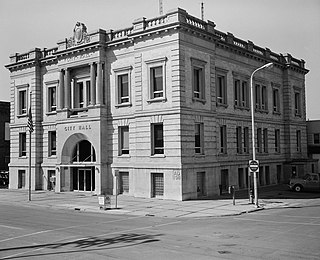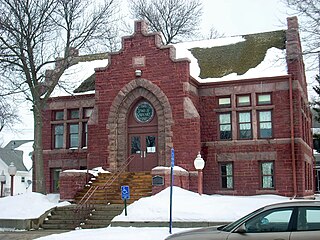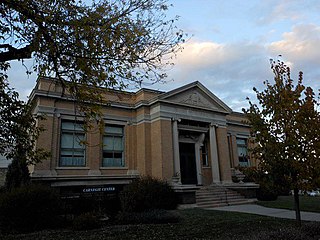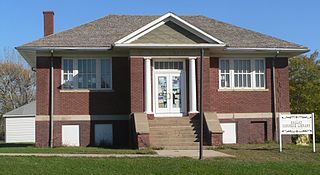
Grafton is a city in the State of North Dakota and is the county seat of Walsh County. As of the 2010 Census, the city of Grafton had a population of 4,284, making it the fourteenth largest city in North Dakota. Grafton was founded in 1881.

Lincoln Heights Branch Library is the second oldest branch library in the Los Angeles Public Library system. Located in the Lincoln Heights section of Los Angeles, California, it was built in the Classical Revival and Italian Renaissance Revival styles in 1916 with a grant from Andrew Carnegie. One of three surviving Carnegie libraries in Los Angeles, it has been designated as a Historic-Cultural Monument and listed on the National Register of Historic Places.

The Sioux Quartzite is a Proterozoic quartzite that is found in the region around the intersection of Minnesota, South Dakota, and Iowa, and correlates with other rock units throughout the upper midwestern and southwestern United States. It was formed by braided river deposits, and its correlative units are thought to possibly define a large sedimentary wedge that once covered the passive margin on the then-southern side of the North American craton. In human history, it provided the catlinite, or pipestone, that was used by the Plains Indians to carve ceremonial pipes. With the arrival of Europeans, it was heavily quarried for building stone, and was used in many prominent structures in Sioux Falls, South Dakota and shipped to construction sites around the Midwest. Sioux Quartzite has been and continues to be quarried in Jasper, Minnesota at the Jasper Stone Company and Quarry, which itself was posted to the National Register of Historic Places on January 5, 1978. Jasper, Minnesota contains many turn-of-the-century quartzite buildings, including the school, churches and several other public and private structures, mostly abandoned.

The Frances Perkins Branch Library, formerly known as the Greendale Branch Library, is a branch library in the public library system of Worcester, Massachusetts. It is located at 470 West Boylston Street, in an architecturally distinguished building, funded in part by Andrew Carnegie and built in 1913. The building was listed on the National Register of Historic Places in 1980.

Joseph Bell DeRemer (1871–1944), who lived and worked in Grand Forks, North Dakota, was one of the finest architects in North Dakota. Some of the important works produced by him or his firm, which included his son Samuel Teel DeRemer, include the President's House at the University of North Dakota, the Masonic Temple, and the Art Moderne United Lutheran Church and North Dakota State Capitol skyscraper. Joseph DeRemer also designed houses in the Grand Forks Near Southside Historic District, most notably the Tudor Revival house presently located at 521 South Sixth Street off Reeves Drive. His significant works include a number of buildings that are listed on the U.S. National Register of Historic Places.

Grand Forks City Hall is a building in Grand Forks, North Dakota that was listed on the National Register of Historic Places in 1982.

Joseph Schwartz, known also as Josef Schwartz, was a notable architect of Sioux Falls, South Dakota.

The Valley City Barnes County Public Library, also known as Valley City Public Library or the Valley City Carnegie Library, in Valley City, North Dakota is a Carnegie library that was built in 1903. It was listed on the National Register of Historic Places in 1979.

William F. Kurke (1889–1965) was a prolific architect in North Dakota.

The Devils Lake Carnegie Library is a Carnegie library located in Devils Lake, North Dakota. It was built in 1909 and designed by architect Joseph A. Shannon. It was listed on the National Register of Historic Places in 2002.

Minot Carnegie Library on 2nd Ave., SE, in Downtown Minot, North Dakota.

The Carnegie Free Public Library, also known as the Carnegie Town Hall, is a historic Carnegie library located at 235 W. 10th St. in Sioux Falls, South Dakota. The library was built in 1903 through a $25,000 grant from the Carnegie Foundation. Architect Joseph Schwartz designed the building, a Romanesque Revival structure with Neoclassical influences. The library was built from locally quarried quartzite, a popular local building material at the turn of the century. While the building's massive form and rough-hewn stone exterior are Romanesque, it features a Greek pediment above the entrance supported by four pilasters on either side of the doorway. The building represents the only use of Classical details in a quartzite building in Sioux Falls.

Frederick W. Keith (1879-1954) was an American architect, beginning his career in Indianola, Iowa but gaining prominence while practicing in Grand Forks, Bismarck, and Fargo, North Dakota. After a successful independent practice, he joined forces with William F. Kurke as Keith & Kurke.

The Carnegie-Stout Public Library is located in Dubuque, Iowa, United States. The public library had its beginnings with the Young Men's Literary Association, established in 1859, and their book collection was the basis for the library's collection. The books were housed in a variety of buildings over the years. The community applied for a grant from Andrew Carnegie who on January 12, 1901, contributed $71,500 to build the library building. Local businessman Frank D. Stout donated the property, which was worth $20,000, in honor of his father Henry L. Stout. The two-story Bedford stone and brick building was designed by Chicago architects W. G. Williamson and John Spencer. It is considered one of the finest examples of the Classical tradition of Beaux-Arts architecture in Iowa. The main facade is dominated by a Roman Corinthian portico that was modeled after the Pantheon in Rome. Its fluted columns are matched with pilasters on the wall behind. The building was dedicated on October 17, 1902, and it opened three days later. It was individually listed on the National Register of Historic Places in 1975, and it was included as a contributing property in the Jackson Park Historic District in 1986. An addition was added to the east side of the building in 1981.

The Dallas Carnegie Library, located off US 18 in Dallas, South Dakota, is a Carnegie library built in 1913. It was listed on the National Register of Historic Places in 1976.
The Wessington Springs Carnegie Library, at 124 N. Main Ave. in Wessington Springs, South Dakota, is a Carnegie library built in 1917–18. It is Prairie School in style. It was listed on the National Register of Historic Places in 1999.
Eisentraut, Colby, & Pottinger was an architectural firm located in Sioux City, Iowa. It designed a number of buildings, including Carnegie libraries and courthouses, several of which are listed on the National Register of Historic Places. It included principal John P. Eisentraut (1870-1958) and has also been known as Eisentraut and Co..

The Dickinson Branch Library, at 1545 Hooker St. in the West Colfax neighborhood of Denver, Colorado, is a Carnegie library which was built in 1914. It was listed on the National Register of Historic Places in 2002.



















